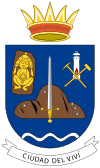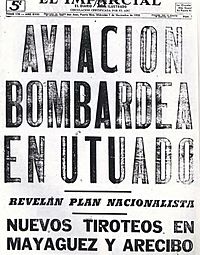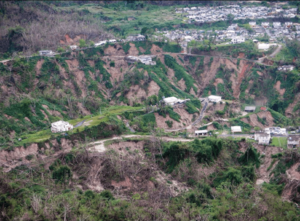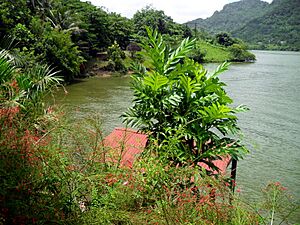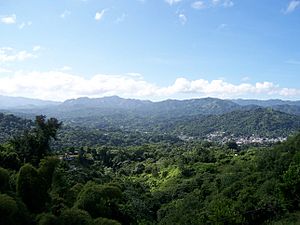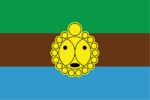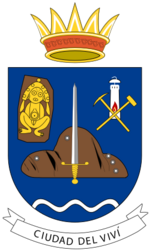Utuado, Puerto Rico facts for kids
Quick facts for kids
Utuado
Municipio de Utuado
Otoao
|
|||
|---|---|---|---|
|
Town and Municipality
|
|||
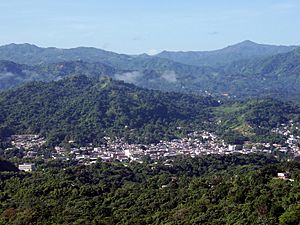
View of Utuado Pueblo from Sabana Grande barrio
|
|||
|
|||
| Nicknames:
Ciudad del Viví, Los Montañeses, Cuna de Campeones
|
|||
| Anthem: "Valle Bendito el de Mi Otoao" | |||

Map of Puerto Rico highlighting Utuado Municipality
|
|||
| Commonwealth | |||
| Settled | 16th-century | ||
| Founded | October 12, 1739 | ||
| Founded by | Sebastian Murphy | ||
| Barrios | |||
| Area | |||
| • Total | 114.99 sq mi (297.83 km2) | ||
| • Land | 113.45 sq mi (293.83 km2) | ||
| Population
(2020)
|
|||
| • Total | 28,287 | ||
| • Rank | 44th in Puerto Rico | ||
| • Density | 245.989/sq mi (94.977/km2) | ||
| Demonym(s) | Utuadeños | ||
| Time zone | UTC−4 (AST) | ||
| ZIP Codes |
00641, 00611
|
||
| Area code(s) | 787/939 | ||
| Major routes | |||
Utuado (Spanish pronunciation: [uˈtwaðo]) is a town and municipality in Puerto Rico. It is located in the central mountains of the island, an area called the Cordillera Central. Utuado is north of Adjuntas and Ponce. It is south of Hatillo and Arecibo. To its east are Ciales and Jayuya, and to its west is Lares.
Utuado is the third-largest municipality in Puerto Rico by land area. Only Arecibo and Ponce are larger. In 2020, about 28,287 people lived there. This population is spread across 24 areas called barrios and the main downtown area, Utuado pueblo. Utuado is also part of the larger San Juan-Caguas-Fajardo Combined Statistical Area.
Contents
What Does Utuado Mean?
The name Utuado comes from the Taíno word otoao. This word means "between mountains," like a valley. The letters "o" and "u" were often used interchangeably in Taíno.
Utuado is also known as Ciudad del Viví, which means "Viví City." This name comes from the Viví River that flows through the area. Two branches of the river meet near Fernando L. Ribas Dominicci Avenue and then flow into Lago Dos Bocas.
A Look at Utuado's History
The town of Utuado was officially founded on October 12, 1739. An Irishman named Sebastian de Morfi (also known as Sebastian Murphy) started the town with 60 families from Arecibo. It was the first town built in the mountainous center of Puerto Rico. Utuado is the 11th oldest municipality on the island.
When Columbus Arrived
When Christopher Columbus arrived in Puerto Rico on November 19, 1493, the island was home to the Taíno people. The Taínos had a well-developed society. They had their own language, farming methods, and a social system led by caciques or chiefs. The Utuado area was ruled by a chief named Guarionex.
In Caguana, the Taínos built special courts called bateyes. These courts, known as the Caguana Ceremonial Ball Courts Site, are the largest example of Taíno building skills in the West Indies. This site is now a US National Historic Landmark.
Early Years: 1500s to 1700s
Between 1510 and 1513, the Taíno people rebelled against the Spanish settlers. This happened because the Spanish treated them very harshly. After this, many Spaniards settled in the Utuado area. They started farms, called haciendas, to grow food for the Taíno slaves working in gold mines and for the Spanish colonists.
One of the first settlers in the Otoao region was Antonio Sedeño in 1512. He was the island's bookkeeper. His farm mainly grew yuca. Later, in 1519, his farm was sold to Blas de Villasante, the island's treasurer.
Gold was mined in areas like Salto Arriba barrio and later in the 1530s, in Caguana and Don Alonso barrios. In the 1530s, landowners in Don Alonso asked the Spanish Crown to create a town there, but it was never approved.
After the gold mining ended in the late 1500s, not much is known about the Utuado region until the early 1700s. Historian Fernando Picó says that the area was mostly empty and covered in thick forests. He also notes that Utuado has the most caves, which were likely used by Taínos or runaway slaves.
In 1771, Fray Iñigo Abbad y Lasierra visited the island. He reported that the main economic activity in Utuado was raising cattle, horses, and mules. People also grew a small amount of tobacco and coffee, but only for their own use.
During the late 1700s and early 1800s, Utuado's population grew. Coffee became very important, and growers needed high, mountainous land to grow the best coffee beans. People moved to Utuado from other parts of Puerto Rico and from places like Ireland and the Canary Islands. They all hoped to get rich from coffee.
The Golden Age of Coffee
In the late 1800s, Utuado's economy grew very quickly because of coffee farming. Coffee was even called oro negro, or "black gold." By the 1890s, Utuado was the biggest coffee producer in Puerto Rico. It also had the second-largest population after Ponce.
Life in Utuado became very rich for many citizens. A casino and a theater were built in the town. The town's progress was so clear that the Queen of Spain, María Cristina, gave Utuado the title of Ciudad (City) on August 20, 1894.
Around 1896 or 1897, Utuado was the first city in Puerto Rico to have public electric lights. These lights were powered by a hydraulic turbine power plant. In the same year, Mayor Juan Casellas planned a train system to connect Utuado with Arecibo.
This golden age ended by 1899 because of two main events. First, the United States took over the island in 1898 after the Spanish–American War. This made sugar the most important crop instead of coffee. Utuado's mountains were not good for growing sugarcane, so it could not compete in the sugar industry. Second, Hurricane San Ciriaco in 1899 destroyed the coffee farms.
Utuado was the first municipality to elect its leaders after Spain gave Puerto Rico to the United States.
A Difficult Time
On October 30, 1950, a sad event happened in Utuado. It was during a time of protests against United States rule, known as the Utuado uprising. A group of 32 nationalists, led by Heriberto Castro and Damián Torres, fought against the local police.
The group was reduced to 12 men and went to Damián Torres' house. The house was attacked by machine-gun fire from ten American P-47 Thunderbolt planes. The National Guard arrived later and told the nine survivors to give up. After they surrendered, they were forced to march to the main town square. Their shoes, belts, and personal items were taken away. Then, the group was taken behind the police station, where five of them died.
Hurricane Maria's Impact
Hurricane Maria hit Puerto Rico on September 20, 2017. It caused many landslides in Utuado. In some areas, there were more than 25 landslides per square mile because of the heavy rain from the hurricane.
Geography of Utuado
Utuado is located in the central mountainous region of Puerto Rico.
Barrios of Utuado
Like all municipalities in Puerto Rico, Utuado is divided into smaller areas called barrios. The main town area, with the municipal buildings, central square, and Catholic church, is called "el pueblo".
Utuado has 24 barrios:
Special Communities
Some communities in Puerto Rico are called Comunidades Especiales de Puerto Rico (Special Communities of Puerto Rico). These are areas where people might face challenges or social exclusion. In Utuado, some of these special communities include: Altos de Arena, Sector El Guano in Arenas Abajo, Sector Las Cuevas in Viví Abajo, Sector Mina de Oro in Ángeles Poblado, Sector Jácanas in Caguana, Mameyes, Caniaco, Cayuco, Chorreras, Don Alonso Motor, El Ensanche, El Hoyo in Mameyes, Judea, La Granja, La Playita, Loma Maestre, Lomas Colón (Colón neighborhood), Los Pinos, Matadero Viejo, Nuevo Londres, Sector (Calle) San Antonio, Sector Cuba, Sector (Calle) Borinquén, Tetuán III, and Calle Progreso in barrio-pueblo.
Utuado's Population Over Time
| Historical population | |||
|---|---|---|---|
| Census | Pop. | %± | |
| 1900 | 43,860 | — | |
| 1910 | 41,054 | −6.4% | |
| 1920 | 35,135 | −14.4% | |
| 1930 | 37,434 | 6.5% | |
| 1940 | 42,531 | 13.6% | |
| 1950 | 46,625 | 9.6% | |
| 1960 | 40,449 | −13.2% | |
| 1970 | 35,494 | −12.2% | |
| 1980 | 34,505 | −2.8% | |
| 1990 | 34,980 | 1.4% | |
| 2000 | 35,336 | 1.0% | |
| 2010 | 33,149 | −6.2% | |
| 2020 | 28,287 | −14.7% | |
| U.S. Decennial Census 1899 (shown as 1900) 1910–1930 1930–1950 1960–2000 2010 2020 |
|||
Exploring Utuado: Landmarks and Sights
Utuado offers several interesting places to visit:
- El Saltillo waterfall
- Dos Bocas Lake
- Caonillas Lake
- Hacienda Roses
- Monuments to the Utuado Soldiers
- Caguana Ceremonial Ball Courts Site
- Río Abajo State Forest
Utuado Pueblo is the main town center. It has narrow streets leading to a central plaza, a church, and the mayor's house. This design is typical of towns built during the Spanish colonial era in Puerto Rico.
The Iglesia San Miguel Arcangel, the local Catholic church, was founded in 1746. The church you see today, with its two steeples, was built between 1872 and 1878. It is listed on the National Register of Historic Places. Also on this list are the Caguana Ceremonial Park and the Blanco Bridge (Puente Blanco). This bridge is in Arenas barrio and connects Utuado with Adjuntas. Other old buildings in Utuado Pueblo that still show their colonial style include The Center for Art, Culture and Tourism and the old hospital, Hospital Catalina Figueras.
The Rio Abajo State Forest (Bosque Estatal Rio Abajo) is a large forest reserve. It covers about 5,780 acres (23.4 km²) and is shared with Arecibo. This forest is home to 223 types of plants and animals. You can find native ceiba trees, Asian teaks, West Indian mahogany, Honduran mahogany, and Australian pines here. It is also a home for the endangered Puerto Rican broad-winged hawk. The critically endangered Puerto Rican parrot is also found here. Parrots raised in captivity are being released into Río Abajo to create a new population on the island.
East of the Rio Abajo Forest Reserve is the Dos Bocas Lake and its dam. This is one of several man-made lakes in Utuado. From El Embarcadero, you can take a boat ride around the lake. There are many restaurants along the lakeside where you can eat.
The Caonillas Lake and dam are in the western part of Utuado. This is another man-made lake, covering over 50 square miles (130 km²). It was built in 1948 by the Puerto Rico Electric Power Authority.
Utuado's Economy
Farming in Utuado
Utuado has started to produce a lot of coffee again. In 2002, it was the 3rd largest coffee producer in Puerto Rico. The town also grows oranges (4th largest producer), plantains (6th largest), and bananas (9th largest). Utuado is also successful in raising animals. It ranks 3rd in bees and 13th in pigs. For manufacturing, Utuado has factories that make textiles, paper, and stone products.
Local Businesses
Today, Utuado has modern communication systems. Major cell phone companies like Claro and AT&T provide mobile service. Liberty Cablevision and DirecTV offer cable and satellite television, with both Spanish and English channels, as well as high-speed Internet.
Culture and Fun in Utuado
Baseball Team
The Montañeses de Utuado (Utuado Mountaineers) are a semi-professional baseball team. They play in the Puerto Rico Amateur Baseball Federation's Liga Doble A. The team won its first national championship in 1941. They won again in 1970, 2007, and 2014.
On May 16, 2019, the Montañeses signed Diamilette Quiles. She became the first female player for the team and the first female signed in Béisbol Doble A.
Table Tennis Stars
Utuado is known for its talented table tennis players. These include the sisters Adriana, Melanie, Gabriela, and Fabiola Díaz. Also, Brian Afanador (cousin to the Díaz sisters), Daniel González, Richard Pietri, Daniely Ríos, and Yomar González are from Utuado. They are all part of the Águilas de la Montaña Table Tennis Club. Brian Afanador and Adriana Diaz have become very famous in table tennis across the Caribbean, Latin America, and the world. Their main coaches are Bladimir Diaz (father of the Díaz sisters) and Eladio Afanador.
Festivals and Events
Utuado celebrates its patron saint festival in September. The Fiestas Patronales de San Miguel Arcangel honors the archangel Michael. This celebration usually includes games, local artisans, rides, regional food, and live entertainment.
Other fun festivals and events in Utuado include:
- National BBQ Festival – This festival started with locals Samuel Kanig and Ramon G. Garcia. It's a one-day event held on the first Sunday of January. Families show off their creative barbecues made from unusual items like toolboxes or even cars!
- Juan Domingo Reyes Negrón Bike Day of Friendship – This annual bike day has been celebrated since 2001, usually in February or March. It remembers Juan Domingo Reyes Negrón, a boy who died in a bike accident.
- Barrio Ángeles Fiesta – Held in April.
- Tierra Adentro Festival – Hosted every year by the Agricultural Technology department of the University of Puerto Rico at Utuado. It features arts and crafts, cultural music, food, and animal displays. This festival takes place in April.
- Guarionex Fiestas – Celebrated in April.
- Ángeles Artisanal Fair – An annual arts and crafts fair in early May in Ángeles barrio. It features local artists, music, and food.
- Rosary Cross Day – Celebrated in May.
- Longaniza Festival – This festival started in June 2009. It was a dream of Don Jose A. Carmona "Don Toño" to celebrate his special sausage recipe and bring a unique event to the mountain town.
- Otoao Cultural Festival – An annual cultural event held in early December. It celebrates Utuado's Taíno heritage.
Getting Around Utuado
With the recent completion of Highway 10, it's now much easier to reach Utuado from the San Juan metropolitan area. What used to be a 3-hour drive is now about 1 hour and 30 minutes to the town center.
Utuado has 64 bridges. Many of Utuado's roads and bridges were damaged by Hurricane Maria in 2017. The hurricane caused about $36 million in damage to the roads and bridges. Funding to rebuild a bridge in Arenas barrio, which was destroyed by Hurricane Maria, was approved in February 2021, and work was planned to start in June.
Symbols of Utuado
The municipality has an official flag and coat of arms. The flag, coat of arms, and anthem of Utuado were all adopted in 1987. They were designed by Amílcar Rivera Díaz, who also wrote the anthem.
Utuado's Flag
The flag has three horizontal stripes: green, brown, and blue. Green represents the town's mountains. Brown stands for the fertile soil. Blue symbolizes the many rivers in the municipality. In the center of the flag is the sun of Otoao, which is a Taíno symbol for the sun.
Utuado's Coat of Arms
The coat of arms has a shield with a cemí (a Taíno deity or spirit) and a silver sword. The color of the cemí represents the earth. The silver sword with a gold handle reminds us of Saint Michael, who is the town's patron saint. The Taíno figure on the top left symbolizes the "Caguana woman."
The mine, the peak, and the gold shovel crossed by a miner's lamp show the mineral wealth of the area. The blue background of the coat of arms represents the skies. The white stripe at the bottom stands for the Viví River that flows through the town.
Utuado's Anthem
The anthem of Utuado is called "Valle Bendito el de Mi Otoao" (Blessed Valley of my Otoao).
Education in Utuado
Utuado has 20 public schools under the Puerto Rico Department of Education. There are also 2 private schools and one college. Most children in Utuado attend public schools.
Some of the main elementary schools include María Libertad Gómez, Bernardo González, and Judith A. Vivas. For middle and high school, there are Francisco Ramos Middle School, Luis Muñoz Rivera High School, and Antonio Reyes Padilla Vocational High School. The two private elementary schools are Colegio Utuadeño San José and Academia Dailén.
The University of Puerto Rico at Utuado was founded in 1979. It is the newest campus of the University of Puerto Rico. This college specializes in agricultural studies, such as pest control, growing plants, livestock, and farm production.
Famous People from Utuado
Many notable people come from Utuado:
- Celimar Adames, a journalist and lawyer
- Brian Afanador, an Olympian and table tennis athlete
- Roberto Cortés, a weather anchor for Telemundo Puerto Rico
- Adriana and Melanie Díaz, Olympians and table tennis athletes
- PFC Fernando Luis García Ledesma, a US Marine who died in the Korean War
- María Libertad Gómez Garriga, an educator and politician
- Marisol Malaret, Miss Puerto Rico 1970 and Miss Universe 1970
- Ana Dolores Pérez Marchand, one of the first Puerto Rican women to become a doctor
- Major Fernando L. Ribas Dominicci, a US Air Force pilot who died in Operation El Dorado Canyon
- Luis Daniel Rivera, an actor and politician
- Melvin "Memo" Rodriguez, a baseball player
- Nuria Sebazco, a news reporter
- Katiria Soto, a journalist
- Ramona Trinidad Iglesias (1889–2004), once the world's oldest person
- Normando Valentín, a news reporter and anchor
- Kefrén Velázquez, a sports journalist
Images for kids
See also
 In Spanish: Utuado para niños
In Spanish: Utuado para niños



